View in other NatureServe Network Field Guides
NatureServe
Montana
Utah
Wyoming
Idaho
Wisconsin
British Columbia
South Carolina
Yukon
California
New York
Lake Chub - Couesius plumbeus
State Rank Reason (see State Rank above)
Species is widely distributed, declining and faces threats from warming water temperatures and drought, and invasive predators
General Description
The lake chub is a native minnow found in Montana's eastern and northern drainages. They are an indicator species of the core prairie fish assemblage found in the Perennial Prairie Stream Aquatic Ecological System. Lake chubs are usually 6 inches or less in length (can be confused with creek chubs in the southern part of their MT range), and are reported to be an important forage fish in some locations. Lake chubs generally prefer small, slow streams and have been illegally introduced in several mountain lakes.
Diagnostic Characteristics
Silver gray overall, dusky on back, underside whitish. A midside band is present but often indistinct. Scattered dark scales may be present, giving a speckled appearance. Breeding males develop reddish patches, particularly on the pectoral fin bases. A well-developed, rounded barbel is located slightly above each corner of the mouth.
Species Range
Montana Range
Range Descriptions
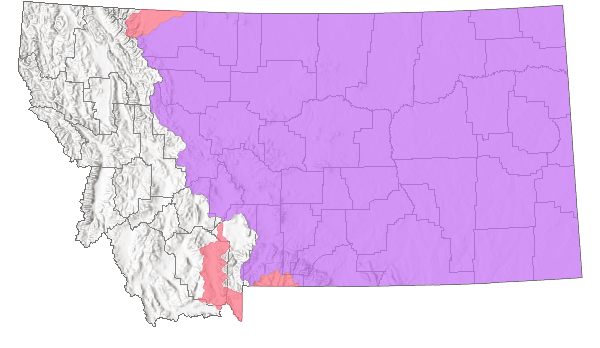 Western Hemisphere Range
Western Hemisphere Range
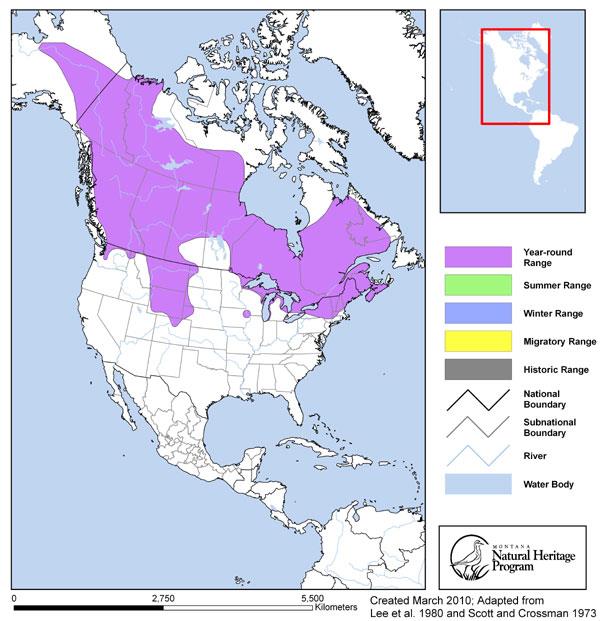
Observations in Montana Natural Heritage Program Database
Number of Observations: 1390
(Click on the following maps and charts to see full sized version)
Map Help and Descriptions
Relative Density
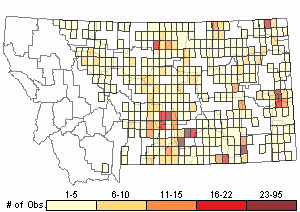
Recency
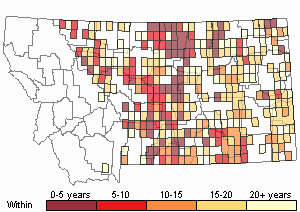

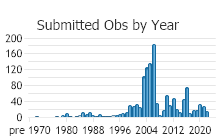
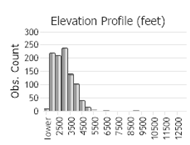 (Observations spanning multiple months or years are excluded from time charts)
(Observations spanning multiple months or years are excluded from time charts)
Migration
Runs out of lakes up to a mile or more to spawn in streams.
Habitat
Favors creek type habitat, mostly at lower elevations, and is rarely found in the larger streams. Also in some mountain lakes.
Food Habits
Feeds on plankton and small aquatic invertebrates
Ecology
May cross with longnose dace. No hybrids reported in Montana.
Reproductive Characteristics
Most are sexually mature at 3 yrs. Spawns mid May - mid June when water temps. reach 50 degrees F. No parental care. Eggs hatch in 10 days at 56 degrees F.
Stewardship Responsibility
References
- Literature Cited AboveLegend:
 View Online Publication
View Online Publication Lee, D.S., C.R. Gilbert, C.H. Hocutt, R.E. Jenkins, D. E. McAllister, J. R. Stauffer, Jr. 1980. Atlas of North American freshwater fishes. North Carolina State Musuem of Natural History. 867 p.
Lee, D.S., C.R. Gilbert, C.H. Hocutt, R.E. Jenkins, D. E. McAllister, J. R. Stauffer, Jr. 1980. Atlas of North American freshwater fishes. North Carolina State Musuem of Natural History. 867 p. Scott, W.B. and E.J. Crossman. 1973. Rainbow trout, Kamloops trout, Steelhead trout Salmo gairdneri Richardson. pp. 184-191. In: Freshwater fishes of Canada. Ottawa, Canada: Fisheries Research Board of Canada, Bulletin 184. 966 p.
Scott, W.B. and E.J. Crossman. 1973. Rainbow trout, Kamloops trout, Steelhead trout Salmo gairdneri Richardson. pp. 184-191. In: Freshwater fishes of Canada. Ottawa, Canada: Fisheries Research Board of Canada, Bulletin 184. 966 p.
- Additional ReferencesLegend:
 View Online Publication
View Online Publication
Do you know of a citation we're missing? Barndt, S.A. 1996. The Biology and Status of the Arctic Grayling in Sunnyslope Canal, Montana. M.Sc. Thesis. Bozeman, MT: Montana State University. 136 p.
Barndt, S.A. 1996. The Biology and Status of the Arctic Grayling in Sunnyslope Canal, Montana. M.Sc. Thesis. Bozeman, MT: Montana State University. 136 p. Clancey, C.G. 1978. The fish and aquatic invertebrates in Sarpy Creek, Montana. M.Sc. Thesis. Bozeman, MT: Montana State University. 54 p.
Clancey, C.G. 1978. The fish and aquatic invertebrates in Sarpy Creek, Montana. M.Sc. Thesis. Bozeman, MT: Montana State University. 54 p. Duncan, M.B. 2019. Distributions, abundances, and movements of small, nongame fishes in a large Great Plains river network. Ph.D. Dissertation. Bozeman, MT: Montana State University. 255 p.
Duncan, M.B. 2019. Distributions, abundances, and movements of small, nongame fishes in a large Great Plains river network. Ph.D. Dissertation. Bozeman, MT: Montana State University. 255 p. Gilham, A.T. 2016. Relationship between intensity of livestock grazing and trout biomass in headwaters of east front rocky mountain streams, Montana. M.Sc. Thesis. Bozeman, MT: Montana State University. 45 p.
Gilham, A.T. 2016. Relationship between intensity of livestock grazing and trout biomass in headwaters of east front rocky mountain streams, Montana. M.Sc. Thesis. Bozeman, MT: Montana State University. 45 p. Hendricks, P., S. Lenard, D.M. Stagliano, and B.A. Maxell. 2013. Baseline nongame wildlife surveys on the Fort Peck Indian Reservation. Report to the Assiniboine and Sioux Tribes of the Fort Peck Indian Reservation. Montana Natural Heritage Program, Helena, MT. 83 p.
Hendricks, P., S. Lenard, D.M. Stagliano, and B.A. Maxell. 2013. Baseline nongame wildlife surveys on the Fort Peck Indian Reservation. Report to the Assiniboine and Sioux Tribes of the Fort Peck Indian Reservation. Montana Natural Heritage Program, Helena, MT. 83 p. Joslin, Gayle, and Heidi B. Youmans. 1999. Effects of recreation on Rocky Mountain wildlife: a review for Montana. [Montana]: Montana Chapter of the Wildlife Society.
Joslin, Gayle, and Heidi B. Youmans. 1999. Effects of recreation on Rocky Mountain wildlife: a review for Montana. [Montana]: Montana Chapter of the Wildlife Society. Mullen, J.A. 2007. Spatiotemporal variation of fish assemblages in Montana prairie streams. M.Sc. Thesis. Bozeman, MT: Montana State University. 102 p.
Mullen, J.A. 2007. Spatiotemporal variation of fish assemblages in Montana prairie streams. M.Sc. Thesis. Bozeman, MT: Montana State University. 102 p. Mullins, M.S. 1991. Biology and predator use of cisco (Coregonus artedi) in Fort Peck Reservoir, Montana. M.Sc. Thesis. Bozeman, MT: Montana State University. 68 p.
Mullins, M.S. 1991. Biology and predator use of cisco (Coregonus artedi) in Fort Peck Reservoir, Montana. M.Sc. Thesis. Bozeman, MT: Montana State University. 68 p. Poole, A.S. 2019. Evaluation of embryo suppression methods for nonnative Lake Trout in Yellowstone Lake, Yellowstone National Park, Wyoming, USA. M.Sc. Thesis. Bozeman, MT: Montana State University. 108 p.
Poole, A.S. 2019. Evaluation of embryo suppression methods for nonnative Lake Trout in Yellowstone Lake, Yellowstone National Park, Wyoming, USA. M.Sc. Thesis. Bozeman, MT: Montana State University. 108 p. Reinhart, D.P. 1990. Grizzly bear habitat use on cutthroat trout spawning streams in tributaries of Yellowstone Lake. M.Sc. Thesis. Bozeman, MT: Montana State University. 128 p.
Reinhart, D.P. 1990. Grizzly bear habitat use on cutthroat trout spawning streams in tributaries of Yellowstone Lake. M.Sc. Thesis. Bozeman, MT: Montana State University. 128 p. Sanborn, B.W. 1990. The ecology of Rainbow Trout in the Bighorn River, Montana. M.Sc. Thesis. Bozeman, Montana: Montana State University. 63 p.
Sanborn, B.W. 1990. The ecology of Rainbow Trout in the Bighorn River, Montana. M.Sc. Thesis. Bozeman, Montana: Montana State University. 63 p. Schultz, L.P. 1941. Fishes of Glacier National Park, Montana. USDI Conservation Bulletin No. 22. Washington D.C.: US Government Printing Office. 42 p.
Schultz, L.P. 1941. Fishes of Glacier National Park, Montana. USDI Conservation Bulletin No. 22. Washington D.C.: US Government Printing Office. 42 p. Stash, S.W. 2001. Distribution, relative abundance, and habitat associations of Milk River fishes related to irrigation diversion dams. M.Sc. Thesis. Bozeman, MT: Montana State University. 82 p.
Stash, S.W. 2001. Distribution, relative abundance, and habitat associations of Milk River fishes related to irrigation diversion dams. M.Sc. Thesis. Bozeman, MT: Montana State University. 82 p. Stringer, A.L. 2018. Status of Northern Pearl Dace and chrosomid dace in prairie streams of Montana. M.Sc. Thesis. Bozeman, MT: Montana State University. 150 p.
Stringer, A.L. 2018. Status of Northern Pearl Dace and chrosomid dace in prairie streams of Montana. M.Sc. Thesis. Bozeman, MT: Montana State University. 150 p. Williams, J.R. 2019. Quantifying the spatial structure of invasive Lake Trout in Yellowstone Lake to improve suppression efficacy. M.Sc. Thesis. Bozeman, MT: University of Montana. 66 p.
Williams, J.R. 2019. Quantifying the spatial structure of invasive Lake Trout in Yellowstone Lake to improve suppression efficacy. M.Sc. Thesis. Bozeman, MT: University of Montana. 66 p. Wuellner, M.R. 2007. Influence of reach and watershed characteristics on fish distributions in small streams of eastern Montana. M.Sc. Thesis. Bozeman, MT: Montana State University. 80 p.
Wuellner, M.R. 2007. Influence of reach and watershed characteristics on fish distributions in small streams of eastern Montana. M.Sc. Thesis. Bozeman, MT: Montana State University. 80 p.
- Web Search Engines for Articles on "Lake Chub"
- Additional Sources of Information Related to "Fish"





